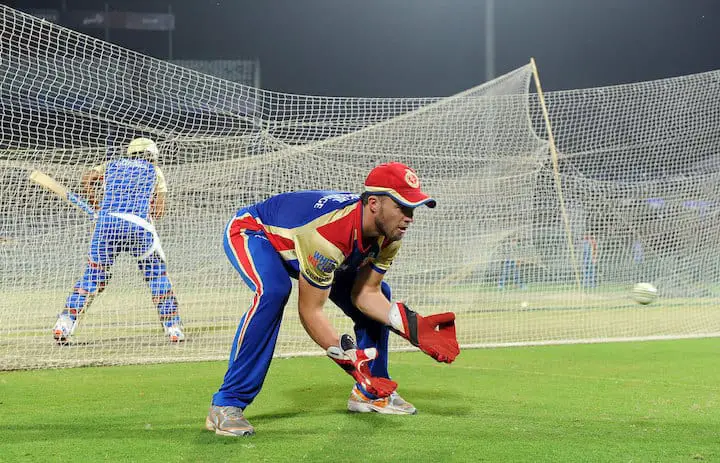
The wicket-keeper is an indivisible part of any fielding team. While we listen to the inspiring anecdotes about the fours, sixes, and mind-boggling hat tricks and match winners, the contribution of a wicket-keeper often goes unnoticed. However, he keeps contributing silently to his team’s success while standing behind the stumps.
A wicket-keeper, in Cricket, is the player who stands behind the wicket at the striker’s end. He is the only player from the fielding side to wear gloves. His role is to catch the ball when missed by the batsman, or when thrown towards him. He is important to affect catching, stumping, and run-out dismissals.
But, there’s a lot that goes into being a great wicket-keeper. Let’s understand the role of wicket-keeper in further detail –
Who is a Wicket-keeper and What is his Role in Cricket?
The role of the wicket-keeper is similar to that of the goalkeeper in Football. The idea is to block the opponent from scoring. But, unlike the goalkeeper, a wicket-keeper is involved in every single ball of the match.
Wicket-keeper belongs to the fielding team. He is the only member of the team allowed to wear gloves and external leg guards. In fact, a fielding team can be penalised if they even wear the gloves of the keeper without taking consent from the umpire. We covered this in an interesting post that talks about some really weird and unknown cricket rules. Do give it a read.
Following are the major tasks that the wicket-keeper has to take care of:
1. Catching the Ball:
Wicket-keeper stops the deliveries that a batsman misses. Without a wicket-keeper, every ball missed by a batsman will result in a four. [If the fielders manage to catch the ball, the opposing team still gets to score a couple of runs.]
2. Affecting Dismissals:
- Stumping: When a batsman leaves the crease to hit a shot and misses the ball, the wicket-keeper catches it and dismisses the player by stumping him out.
- Run-out: The wicket-keeper can also run-out the batsman while he is outside the crease finishing the run.
- Catching: Another major task of a wicket-keeper is to catch the “edges” before the ball touches the ground.
Restrictions on a Wicket-keeper in Cricket
As per the rules of the game, he will always be behind the stumps at the striker’s end. He can’t come ahead of the wickets, from the moment the bowler delivers the ball until:
- The ball strikes the batsman,
- The ball strikes his bat,
- The ball directly hits the stump,
- The batsman moves towards the non-striker’s end, OR
- The striker hits the ball and starts running toward the non-striker end.
If the ball doesn’t touch any of the above things, the wicket-keeper still can’t touch the ball unless the ball has crossed the stump.
A recent incident with Rishab Pant highlights the need to understand this. In the 20-20 International series against Bangladesh, Pant tried collecting the ball before it had crossed the stumps. The ball was declared no-ball.
So, is the Wicket-keeper Even Needed in a Cricket Match?
Absolutely yes! A wicket-keeper plays a crucial role in a cricket match. In addition to the roles mentioned above, a wicket-keeper is also often involved in the following manner –
1. Helping the captain in setting the field:
A wicket-keeper is in a unique position. He can see the field exactly how the batsman sees it. Thus, since the wicket-keeper is always near the batsman, the captain often delegates this task of analysis field that needs to be set for a particular batsman to the wicket-keeper.
2. Helping the captain in the DRS decisions:
When the fielding team’s captain has to ask for DRS [Umpire Decision Review System (UDRS or DRS)], he prefers to first consult the wicket-keeper. Since the wicket-keeper stands behind the stumps, he has a clear view of the batsman’s activity and the movement of the ball. He can make a prudent judgement as to whether or not the team should go for DRS.
Why do Fielders in Cricket Throw the Ball to the Wicket-keeper?
While this is a common activity for most fielding teams, one of the most obvious reasons is that the wicket-keeper is the only player in the fielding team who is allowed to wear the gloves. Needless to say, it is generally safer to throw the ball towards the wicket-keeper than any other player as the chances of the ball being missed when receiving the throw is lower.
Furthermore, a wicket-keeper is trained to grab the ball regardless of difficulty of the throw from the fielder.
Additionally, sometimes the throw from the outfield can also be inaccurate since it is thrown fast from a distance. Thus, it can cause an injury to the bowler or a fielder gathering the throw. However, a wicket-keeper is less prone to such injuries due to the protective gear worn by him.
It is also important to note that there is also often a technical reason for it. As per the rules of cricket, “The ball becomes dead when it is finally settled in the hands of the wicket-keeper or of the bowler.” It means once the wicket-keeper has caught the ball, the batsmen cannot score any more runs.
Can a Wicket-keeper Bowl in a Cricket Match?
Yes, a player who is a wicket-keeper is allowed to bowl in a cricket match. Popular wicket-keepers like Mark Boucher, Adam Gilchrist, Mahendra Singh Dhoni, etc. have done it in the past.
There is no rule that refuses the wicket-keeper to bowl. But, when it happens, he has to be replaced with some other player from the team. Naturally, the wicket-keeper has to remove the gloves and external leg safety pads. The wicket-keeper also has to inform the umpire about the change before any other player wears the gloves and the pads.
The above video showcases Indian wicket-keeper MS Dhoni bowling during a test match versus England. MS Dhoni also kept the wickets in the same match.
Can a Substitute Player Replace a Wicket-keeper in Cricket?
Yes, as per the law 24.2.2 of the “Substitute fielders” rule, “A substitute shall not bowl or act as captain but may act as wicket-keeper only with the consent of the umpires.”
Can a Wicket-keeper be a Captain in Cricket? Are There Any Advantages to it?
Yes, a wicket-keeper can be a captain and there are definitely advantages to it. In fact, there have been several players who have been wicket-keeper and a captain for their respective teams.
Just like the wicket-keeper, a captain also has to be involved in every single delivery of the match. Handling the dual role of being the wicket-keeper as well as the captain ensures that he gets to batsman’s movements closely. He gets to analyse the weak points of the batsman, set the fielding accordingly, and also guide the bowler on what delivery to bowl in order to be most effective.
“People have said in the past that being a wicket-keeper and a captain might be a disadvantage. Now that I’ve done it a bit more, I see it as more of an advantage.”
Tim Paine, Australian wicket-keeper-captain quoted in an interview.
Can a Wicket-keeper Change his Position While the Bowler Prepares to Bowl?
Wicket-keeper’s position can be used tactically to control batsman’s behavior. Based on the bowler and the ball, the wicket-keeper can change his position with the captain’s consent, however, this movement can not be more than a few steps in any direction.
It is important to note that once the bowler delivers the ball, he can’t change his position to be convenient for the wicket. This has exceptions:
- The wicket-keeper can move a little ahead if the delivery is slow. But, not so much that it is very convenient for him to dismiss the player by getting the wicket.
- The wicket-keeper can anticipate the direction of the ball. If the ball is headed towards left, he can move to the left laterally.
- The wicket-keeper can watch and analyze the actions of the batsman. This way he can gauge how and in what direction the batsman intends to hit the ball. The wicket-keeper can move or keep himself ready accordingly.
Can the Wicket-keeper’s Position Compel the Batsman to Change the Behavior?
In special circumstances, the batsman leaves the crease to hit the shot. Here are a couple of situations when this can happen: –
- When the ball is new, it can swing. Therefore, the batsman tends to go outside the crease to avoid the swing.
- To turn the yorker into a full-toss.
In such cases, the team can choose to move the wicket-keeper closer to the stumps. This will compel the batsman to stay inside the crease line & get out of his comfort zone [has to face the difficult bowling!]. If he goes outside & misses the ball, the wicket-keeper can catch it & stump him out instantly.
When a spinner is bowling, the wicket-keeper almost always “stands-up”. The chances of striker missing the ball because of spinning are higher. The wicket-keeper also tries to leverage the “edges”, which are also highly-likely, in this case.
Is the Wicket-keeper’s Task Easiest of Playing XI?
Being a wicket-keeper is not an easy task. Although the task looks simple, there is a lot more that goes into it!
Every remarkable wicket-keeper needs to have an extraordinary blend of –
- Stark focus
- Highly agile reflex actions
- Fitness
- Quick-thinking
- Patience and ability to remain calm in stressful situations
Wicket-keepers’ job is probably the most demanding than every other player on the field. He is the only player in the ground who is involved in every single ball in a match while fielding. Furthermore, a wicket-keeper is also expected to bat well! Not only does he have to be on the field when his team is batting (since he is expected to bat well), but also when the team is fielding!
A wicket-keeper also needs to be physically fit to handle the constant crouching, sprinting, squatting, getting up, jumping, running, & diving. He has to have an impeccable concentration level. Stopping the zippy balls from fast bowlers & catching the returns thrown from a great distance takes its toll.
Being a wicket-keeper can sometimes also be a dangerous task. For example, during a warmup match, South Africa’s Mark Boucher suffered an injury. A ricocheting bail hit his left eye and hurt his lens, iris, and pupil. This injury – laceration to the sclera – put an unfortunate and abrupt end to his golden tenure in cricket. India’ Saba Karim also suffered a similar injury that ended his career.
Who Holds the Record for the Most Dismissal by a Wicketkeeper?
When it comes to a wicket-keeper, there are several statistics and records kept. Let’s look at the Test Match and ODI records by a wicket-keeper.
Wicket Keeping Records in Test Matches

In Test Matches, Mark Boucher holds the record for maximum dismissals affected (555) as well as most catches (532). Australia’s Bert Oldfield holds the record for the highest number of stumpings in Test Matches. He has affected 52 stumpings throughout his career.
Wicket Keeping Records in ODI Matches

When it comes to one-day internationals, Sri Lanka’s Kumar Sangakara has affected maximum dismissals (482) whereas India’s former captain and wicket-keeper Mahendra Singh Dhoni is the king of stumping (123). Australia’s Adam Gilchrist holds the record for the highest number of catches (417)
Final Thoughts
The wicket-keeper is the backbone of the fielding team. The major tasks of the wicket-keeper include blocking the ball deliveries missed by the batsman. This job demands great physical strength as well as strong mental power. A wicket-keeper’s promptness and diligent actions set the mood of the team.
